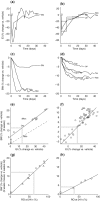Translational Modeling to Guide Study Design and Dose Choice in Obesity Exemplified by AZD1979, a Melanin-concentrating Hormone Receptor 1 Antagonist
- PMID: 28556607
- PMCID: PMC5529746
- DOI: 10.1002/psp4.12199
Translational Modeling to Guide Study Design and Dose Choice in Obesity Exemplified by AZD1979, a Melanin-concentrating Hormone Receptor 1 Antagonist
Abstract
In this study, we present the translational modeling used in the discovery of AZD1979, a melanin-concentrating hormone receptor 1 (MCHr1) antagonist aimed for treatment of obesity. The model quantitatively connects the relevant biomarkers and thereby closes the scaling path from rodent to man, as well as from dose to effect level. The complexity of individual modeling steps depends on the quality and quantity of data as well as the prior information; from semimechanistic body-composition models to standard linear regression. Key predictions are obtained by standard forward simulation (e.g., predicting effect from exposure), as well as non-parametric input estimation (e.g., predicting energy intake from longitudinal body-weight data), across species. The work illustrates how modeling integrates data from several species, fills critical gaps between biomarkers, and supports experimental design and human dose-prediction. We believe this approach can be of general interest for translation in the obesity field, and might inspire translational reasoning more broadly.
© 2017 The Authors CPT: Pharmacometrics & Systems Pharmacology published by Wiley Periodicals, Inc. on behalf of American Society for Clinical Pharmacology and Therapeutics.
Figures





References
-
- Visser, S.A. et al Model‐based drug discovery: implementation and impact. Drug Discov. Today 18, 764–775 (2013). - PubMed
MeSH terms
Substances
LinkOut - more resources
Full Text Sources
Other Literature Sources
Medical

